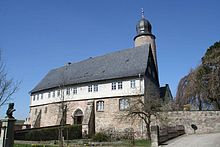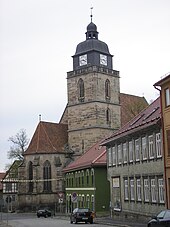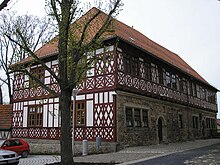Ice field
| coat of arms | Germany map | |
|---|---|---|

|
Coordinates: 50 ° 25 ' N , 10 ° 55' E |
|
| Basic data | ||
| State : | Thuringia | |
| County : | Hildburghausen | |
| Height : | 440 m above sea level NHN | |
| Area : | 86.53 km 2 | |
| Residents: | 7561 (Dec. 31, 2019) | |
| Population density : | 87 inhabitants per km 2 | |
| Postal code : | 98673 | |
| Area code : | 03686 | |
| License plate : | HBN | |
| Community key : | 16 0 69 012 | |
| LOCODE : | DE Oath | |
| City structure: | 7 districts | |
City administration address : |
Marktstrasse 2 98673 Eisfeld |
|
| Website : | ||
| Mayor : | Sven Gregor ( Eisfelder Free Voters ) | |
| Location of the city of Eisfeld in the Hildburghausen district | ||

Eisfeld is a small town in the district of Hildburghausen in the Franconian south of Thuringia on the Thuringian Porcelain Route .
geography
The city is located in the district of Hildburghausen , only a few kilometers from the border with Bavaria in the southern foreland of the Thuringian Forest . At its interface with the Thuringian Slate Mountains and north of the Long Mountains , Eisfeld is 430 to 530 m above sea level. Sea level on the upper reaches of the Werra .
The district of Waffenrod / Hinterrod is about 700 m above sea level near the Grendel mountain .
City structure
According to the main statute, the urban area is divided into the seven districts Eisfeld, Bockstadt-Herbartswind , Harras , Heid , Hirschendorf , Sachsenbrunn and Waffenrod / Hinterrod.
history
Eisfeld was first mentioned as "Asifelden" (presumably in the sense of Count Asis' fields) in a deed of donation from Count Erpho to the Fulda Monastery, dated between 802 and 817 . In the local dialect , Eisfeld is called "Aasfald", which is also attributed to Aasen (Essen). The further history of Eisfeld lies in the dark for several centuries, until Count Berthold VII von Henneberg founded it in 1316 as part of the so-called New Rule Henneberg or Care Coburg with the support of the later Emperor Ludwig of Bavaria , whose adviser he was, from Johann von Brandenburg ( back) acquired. Eisfeld is mentioned as a town for the first time in the relevant document and was given the right to wall up by Count Berthold in 1323. In later documents reference is made to the Coburg and Schweinfurt city rights . However, the city fell by inheritance to the Burgraves of Nuremberg as early as 1353 and in 1374 as part of the maintenance of Coburg under the rule of the Wettins . In the late Middle Ages , Eisfeld was one of the market places on the long-distance trade route between Nuremberg and Erfurt that ran over the Rennsteig .
The Reformation was introduced in 1525 in the city belonging to the diocese of Würzburg . Expelled from Halle , the reformer Justus Jonas the Elder spent his old age in Eisfeld. Since 1485 Eisfeld belonged to the Ernestine part of Kursachsen and from 1645 to Saxe-Gotha . During the Thirty Years War , the city was completely destroyed twice and lost four fifths of its population.
From 1680 to 1826 Eisfeld belonged to Sachsen-Hildburghausen , then to Sachsen-Meiningen . The first economic success came from trading in so-called Schnetter chests - these were elaborately painted, folk-decorated chests and pieces of furniture that were delivered to northern Württemberg, Hesse and Bavaria in the 19th century. The poet Otto Ludwig (1813–1865) spent his youth in a late classicist summer house on the outskirts . In 1858 the Werra Railway was built, and in 1903 the local branch of the SPD was founded. The KPD local group followed in 1920 . On May 1st of the same year the city was opened in the state of Thuringia.
Eisfeld was called a “brown city” because as early as 1932 12 of 16 city councilors belonged to the NSDAP and made Adolf Hitler an honorary citizen . Therefore, in 1933 an intensive persecution of the functionaries and members of the other parties began. During the Second World War , 733 foreign forced laborers , including 542 women, had to do forced labor in the Bruhn works, the Ritzma works, Eiso-Schrauben GmbH and the Günsel and Dressel companies. Three of the forced laborers who died from the inhumane living conditions are buried in the cemetery.
After the Second World War , Eisfeld was in the so-called restricted area along the inner-German border until 1972 because of its proximity to the border .
Incorporations
In 1957 Heid was incorporated , followed in 1993 by the two neighboring communities Harras and Hirschendorf . At the same time, the new district of Waffenrod / Hinterrod, which was merged from the municipalities of Waffenrod and Hinterrod , was incorporated. In 2013, the municipality of Bockstadt with its Herbartswind district, for which Eisfeld had previously been a fulfilling municipality, was incorporated.
In 2019, the municipality of Sachsenbrunn, for which Eisfeld was also a previously fulfilling municipality, was incorporated.
Population development
Development of the population (from 1960 December 31) :
|
1489 to 1960
|
1992 to 1999
|
2000 to 2007
|
2008 to 2015
|
from 2015
|
- Data source from 1994: Thuringian State Office for Statistics
politics
(2014: 51.8%)
City council
The Eisfeld City Council consists of 20 elected members and the mayor. Since the local elections on May 26, 2019 , the first after the incorporation of the former municipality of Sachsenbrunn, the seats of the elected city councils have been distributed as follows:
| Party / list | Seats | +/- |
| EFW | 8th | - 3 |
| FWGS | 3 | + 3 |
| left | 3 | - 1 |
| CDU | 3 | ± 0 |
| SPD | 2 | ± 0 |
| BZH | 1 | + 1 |
The right-wing extremist Bündnis-Zukunft-Hildburghausen (BZH) ran for the first time for the 2019 local elections and moved into the city council.
coat of arms
Blazon : "In gold, a black lion with a red tongue and armor, holding a rooted green linden tree in the front paws."
The coat of arms has been in use in this form since 1960. The lion is tinged as the marrow niche. The oldest city seals show it accompanied by the letter E as a community symbol. Since around the middle of the 17th century, the E has been replaced by the tree sapling, which is interpreted by various chroniclers as a symbol of reconstruction after destruction in the Thirty Years War. Different historical versions of the city arms also show the lion as a Thuringian sevenfold divided by silver and red.
Town twinning
Eisfeld maintains city partnerships with
- Ahorn in the district of Coburg (since 1990) and
- Ham in Picardy (since 1995).
Culture and sights
Buildings
- The medieval Eisfeld Castle is an important architectural monument ; it was built in the 13th century at the highest point of the city on the walls of an older fortification and connected to the city fortifications that are now only in ruins. The simple building complex was the official residence of the rulers, after 1728 it also served as the widow's residence of the Duchess Sophia Albertine of Saxony-Hildburghausen and finally housed the district court with prison. The castle has a horseshoe-shaped floor plan and a round tower with an onion dome rises to the northeast . The castle has been used culturally since 1948/1949, it is home to the Otto Ludwig Museum , which was opened in 1948 under the direction of Ernst Dahinten , with an important collection of regional history.
- The Dreifaltigkeitskirche Eisfeld St. Nikolai from 1535, a major work of the Thuringian late Gothic . The ringing consists of the Great Bell , the Egidius Bell , cast in 1474 , the Banzer, cast in 1581, and the Mess , both of which were stolen from Banz Monastery by Swedish troops during the Thirty Years' War and sold to the city.
- The Otto Ludwig Memorial is located in the Unterm Heinig garden . In addition to the memorabilia from the poet's family property, the place gives an impression of the late classicist interior design.
- The ruins of the Gottesackerkirche St. Salvator are in the old cemetery
- There is a summer toboggan run in the Waffenrod-Hinterrod district .
Events
The ice fields have been celebrating on the 3rd Pentecost Holiday "(Whit Tuesday, Tuesday after Pentecost ) their cow tail festival . Originally a draft and exercise for citizens fit for military service, today it is a big folk festival over the whole Whitsun weekend. To commemorate this exercise, city guards in historical uniforms stand at the entrances to the town on Whit Tuesday and sell symbolic passes. The highlight of the celebrations is a pageant.
dialect
Itzgründisch , a Main Franconian dialect, is spoken in Eisfeld .
Economy and Infrastructure
Until the middle of the 20th century, Eisfeld was - based on the neighboring Sonneberg hinterland - a focus of doll and toy production . The porcelain industry and the manufacture of precision mechanical and optical products have also been of greater economic importance to this day .
In 1920 Albin Ritzmann founded a company in Eisfeld that manufactured, among other things, razor blades and razors. After the Second World War , Ritzmann was expropriated. He died in 1947 in special camp No. 2 Buchenwald . The production of razor blades in the GDR was taken over by the state-owned company "Feintechnik Eisfeld", which established the Croma brand. In the early 1990s, it was privatized as Feintechnik GmbH Eisfeld. The company had 435 employees (as of 2014) and mainly manufactured system razors for women and men as well as replacement blades. In 2014, the company was bought by the New York start-up Harry’s - an online mail order company for shaving supplies - for US $ 100 million. In May 2019 it was announced that the US company Edgewell Personal Care , which also owns Wilkinson Sword , plans to take over the plant with around 600 employees for just under 1.2 billion US dollars by March 2020. In contrast, the US antitrust authorities announced legal action. This resulted in the cancellation of the takeover.
In 1952, VEB Carl Zeiss Jena opened a facility for the production of individual parts for the Jena plant , which was further expanded in the following years. The production of binoculars and riflescopes was relocated to Eisfeld in the mid-1960s and the production of optical analysis measuring devices began. In the 1980s, around 1,100 people worked in the Eisfeld factory, which was then the largest manufacturer of binoculars in Europe. At the beginning of August 1991, Docter Optics GmbH from Wetzlar took over the factory with the remaining 550 employees, but they had to file for bankruptcy in 1995. In 1997, part of the company with a workforce of 40 was continued by Analytik Jena GmbH. Analytik Jena sold its Eisfeld branch in 2016 to Noblex GmbH, which employed 127 people in 2018.
For the 4th quarter of 2019, Progroup , one of the largest corrugated cardboard manufacturers in Europe, plans to commission a corrugated cardboard plant with an annual production capacity of 190,000 tons of corrugated cardboard. This will create 52 jobs and three training positions. At the time of inauguration, the Eisfeld plant would have the second-highest production capacity of any of the company's operations.
traffic
Located on the (former) Bundesstraße 4 between Coburg and Erfurt , Eisfeld suffered from a sharp increase in through traffic after the opening of the inner-German border in 1989. The construction of the federal motorway 73 Nuremberg - Suhl created a connection through the Eisfeld-Nord and Eisfeld-Süd junctions to the supra-regional traffic connections, which also relieves through traffic.
Eisfeld had its first railway connection in 1858 with the Werra Railway heading west to Eisenach and heading south to Coburg. The connection to Coburg has been discontinued since 1945; it was later dismantled. The narrow-gauge line to Schönbrunn was put into operation as the second railway line in 1890 to develop the northern hinterland . This was also dismantled in 1974. Finally, the Eisfeld – Sonneberg railway line was opened in 1909 and is still in operation today.
Public safety, fire safety and health
In addition to the Eisfeld volunteer fire brigade as a base fire brigade for the Hildburghausen district, the rescue station of the Regiomed clinics is also located in Eisfeld . They also operate the local senior center “Am Thomasberg” and a dormitory for the mentally ill and the mentally handicapped .
Personalities
Honorary citizen
- Friedrich Eduard Oberländer (1807–1879), lawyer and politician
- Rudolph Rühle von Lilienstern, judiciary and magistrate
- Johann Nicol Marbach, teacher and cantor in Themar
- Christian and Heinrich Burkhardt, glass painters
- Otto König, merchant in Würzburg
- Max Michaelis, wholesale merchant in London
- William C. Lobenstein, businessman in New York
- Paul von Hindenburg (1847–1934), honorary citizenship revoked by decree in 1945/46
- Adolf Hitler (1889–1945), decided on December 3, 1932, revoked honorary citizenship in 1945/46 by decree
- Ernst Dahinten (1885–1969), teacher, city archivist and museum director
- Alfred Recknagel , physicist and university professor
- Ilse and Hans Melzl (posthumously), doctors in the Eisfeld hospital
sons and daughters of the town
- Georg Rhau (1488–1548), printer and Thomas Cantor
- Johann Dilliger (1593–1647), Protestant theologian and composer
- Georg Decker (1596–1661), printer, publisher, founder of the Basel University Printing Office
- Christoph Philipp Richter (1602–1673), legal scholar
- Carl Barth (1787–1853), draftsman and engraver
- Otto Ludwig (1813–1865), writer
- Christian Heinrich Burckhardt (1824–1893), glass painter
- Georg Credner (1825–1899), educator, preacher and director of the Bremen teachers ' college
- Otto Muther (1832–1881), member of the Coburg state parliament
- Gustav Eichhorn (1862–1929), medic and prehistoric
- Constantin Krauss (1864–1928), chemist and industrialist
- Karl Röhrig (1886–1972), sculptor and porcelain designer
- Ernst Straßner (1905–1991), painter and art teacher
- Alfred Recknagel (1910–1994), physicist and university professor
- Rudi Brehm (1924–1997), trade union official born in the Harras district
- Anita Bach (* 1927), architect and university professor
- Corinna Herold (* 1961), politician (AfD) and member of the state parliament
- Rosso Majores (1911–1996), painter, graphic artist, art teacher, national prize winner
Related to the place
- Justus Jonas the Elder (1493–1555), reformer
- Arsacius Seehofer (around 1505 – around 1540), Reformation theologian, was a schoolmaster in Eisfeld
- Wolfgang Thierse (* 1943), politician (SPD), former President of the German Bundestag
See also
Web links
- Ice field (official website)
Individual evidence
- ^ Population of the municipalities from the Thuringian State Office for Statistics ( help on this ).
- ↑ Main statute of the city of Eisfeld from February 25, 2014, Eisfelder Official Journal, No. 3/2014, p. 3
- ↑ A memorial plaque commemorates his stay.
- ↑ Thuringian Association of the Persecuted of the Nazi Regime - Association of Antifascists and Study Group of German Resistance 1933–1945 (ed.): “Heimatgeschichtlicher Wegweiser zu places of resistance and persecution 1933–1945”. Row: Local History Signposts . Volume 8. Thuringia, Erfurt 2003, p. 124, ISBN 3-88864-343-0
- ^ Thuringian State Office for Statistics - Area changes ice field
- ↑ Contract on the incorporation of the municipality of Bockstadt into the city of Eisfeld, Eisfeld Official Journal, No. 01/2013, p. 7
- ↑ Thuringian Law and Ordinance Gazette No. 14/2018 , accessed on May 20, 2019
- ^ Result of the 2019 local elections in Eisfeld. Retrieved July 15, 2019 .
- ^ Result of the 2014 local elections in Eisfeld. Retrieved July 15, 2019 .
- ^ Otto Ludwig Museum Eisfeld . In: Sparkassen-Kulturstiftung Hessen-Thüringen (Hrsg.): Museums in Thuringia . Frankfurt / Erfurt 1995, p. 54 .
- ↑ Michael J. de la Merced: A Start-Up Run by Friends Takes On Shaving Giants. The New York Times, January 21, 2014, accessed March 22, 2017 .
- ↑ Niklas Wirminghaus: US startup buys 93-year-old factory in Thuringia - for 100 million dollars. Gründerszene, January 23, 2014, accessed on March 22, 2017 .
- ↑ How a Thuringian company got involved in the battle for razor blades , by Niklas Wirminghaus, March 31, 2019 capital.de
- ↑ Progroup: In future, corrugated cardboard will come from Eisfeld , accessed on September 4, 2019.
- ↑ Progroup: Growth Projects , accessed on September 4, 2019.
- ↑ Eisfeld Official Journal, December 5, 2014, p. 14







